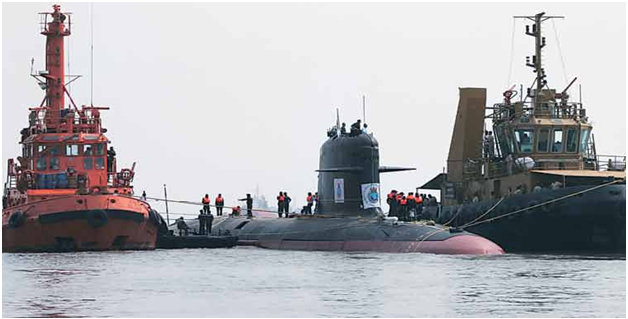Despite Denials, IN Scorpene Fleet Hit Hard by Leaks

NEW DELHI: The Indian government is playing down the consequences of The Australian newspaper detailing the operational, combat and technical details of the Indian Navy’s (IN’s) under-construction fleet of six French Scorpene submarines on 24 August.
Understandably, the IN has officially downplayed the severity of the leak, whilst the Ministry of Defence (MoD) too could not be alarmist in its response.
But privately senior naval officers and planners concede that the pre-eminent function of these diesel-electric boats, under licensed-construction at Mazagaon Dockyard Limited (MDL), has been ‘severely compromised’ by The Australian’s selective leaks from 22,400 pages of the submarines manual in its possession.
These tasks primarily include stealthy underwater war fighting and information gathering, which make submarines highly desirable deterrent weapon platforms, operated by a limited number of countries around the world.
Consequently, the potency of their sonars- employed for navigation, communication, and detection-and operating sound levels -which render them capable of discovery to enemy forces-necessitate the utmost secrecy.
But after the Australian leaks, the IN’s Scorpene fleets critical element of surprise and stealth has ended, as has its attack potential. Enemy navies can now easily adopt counter measures to neutralise and contain the activities of the IN’s Scorpene fleet, once deployed.
Its discoverability rate, in a sense, has multiplied manifold, as the sheer magnitude of the Australian’s exposure is astronomical.
It includes 8,666 pages on the boats underwater and above-water sensors, 4,310 pages on its combat management system, 493 pages on its torpedo launch system and specifications, 6,841 pages on its communication network and 2,138 on its navigation system.
What is it that is left unknown about these boats?
Little, according to independent naval experts;
Lots, according to the IN and phalanx of retired naval officers, posing as professionals, sounding off in television studios. Take your pick.
The IN doggedly has opted to play down the leaks, claiming they do not pose a security compromise, on the laughable grounds that ‘sensitive portions’ had been redacted or blacked out on the Australian’s website.
For the IN’s information, the paper itself had exercised security discretion and opted not to reveal delicate operational information. A naïve IN has to realise that rival forces would not be so understanding or gentlemanly as to pursue Queensbury rules of sea warfare.
The MoD, meanwhile, has instituted a committee to evaluate the potential impact of the leak, but lets face reality: little or nothing will emerge from these investigations and the source of the leak will never ever be pinpointed.
It will, doubtlessly, become mired in speculation, innuendo and conspiracy theories and like innumerable similar instances in the past, truth will be the prime casualty.
Scorpene manufacturers DCNS have already deflected suspicion, by claiming that a former employee pilfered these documents and disseminated them further, as though that mitigates blame.
Corporate espionage too is being darkly mentioned but, once again, with DCNS as the victim.
The inference is that German or Japanese naval manufacturers or possibly, even both, who were bested by DCNS in the race for the $50 billion Australian tender to build 12 Shortfin Barracuda submarines, did the poor French in.
Speculation in security circles is that The Australian was chosen as the platform to leak information on the IN’s Scorpene programme principally to discredit DCNS, as an unreliable partner. This, in turn, would compel Canberra to terminate the submarine tender and award it to one of the other two failed contenders.
This, however, remains in the realm of conjecture and will remain so.
Defence Minister Manohar Parrikar, for his part, has already declared that the leaks emanated from overseas and that naval and MDL information systems were secure and beyond infiltration.
So who is to blame?
The short answer: Nobody.
India, however, now faces the dilemma of whether or not to exercise the option for an add-on order for two or three more Scorpenes after MDL hands over the six compromised boats by 2020-21.
To do so would be political suicide for any administration after the leaks, but the navy’s declining underwater force levels could force a situation in which operational necessity triumphs.
The IN currently operates 13 diesel-electric boats- five less that the sanctioned strength of 18 projected by the navy’s 2012-27 Maritime Capability Perspective Plan-but a majority of these need retiring, upgrading or both.
These include nine Russian-designed ‘Kilo’-class Type EKM boats and four German-designed Type 209/1500 SSKs, mostly inducted into service over 25 years ago.



